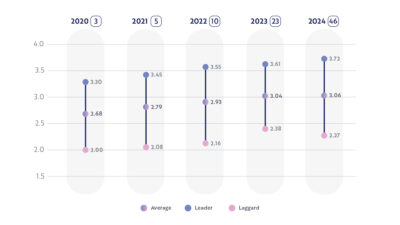
In the corporate world, alignment is often treated as a soft skill—a “nice to have” that sits beneath the radar of more tangible concerns like revenue, efficiency, and growth.
But make no mistake: lack of alignment is one of the most expensive problems in business.
Misaligned teams launch duplicate projects.
They chase conflicting goals.
They burn through budgets and time.
And worst of all—they erode trust.
In digital transformation, the cost of misalignment multiplies. Without clear alignment between business and IT, transformation efforts stall. Technology becomes an end in itself. Roadmaps fragment. Priorities shift with every leadership change. It’s no surprise that over 70% of transformations underdeliver on their intended outcomes.
But what happens when alignment becomes the first goal—not the afterthought?
That’s exactly what one global logistics company discovered.
Case Study: The Turning Point
This logistics business operates across three continents, with complex operations spanning transportation, warehousing, and supply chain services. On paper, they were progressing with digital transformation: they had invested in telematics, warehouse automation, customer portals, and internal analytics tools.
And yet, the leadership team felt stuck.
“We’ve spent millions, but we can’t articulate the value,” said the CFO.
“There’s no cohesion. Everyone’s doing something digital, but no one knows how it all fits,” added the COO.
“We need clarity,” the CIO admitted.
Digitopia was invited to assess the situation—not with a thick report, but with a facilitated digital maturity assessment.
What followed changed the trajectory of their transformation.
The Power of Structured Conversation
We brought 14 senior leaders to the table—business unit heads, technology, operations, HR, finance, and strategy. For many of them, this was the first time they had sat together to discuss digital transformation in a structured, focused way.
The format was simple but powerful: a moderated self-assessment session guided by our DMI framework. Across six dimensions—Strategy, Culture, Technology, Operations, Customer, and Innovation—we asked tough but essential questions. Leaders debated maturity scores, surfaced gaps, and shared frustrations.
The conversation was, at times, uncomfortable. But it was also honest.
“We realized how differently we each saw the state of digital,” one country CEO later admitted.
“We weren’t even speaking the same language,” said the Group CTO.
By the end of the session, they had co-created a shared view of their current maturity: a composite score of 2.6 out of 5.
The biggest takeaway? They weren’t behind in technology—they were behind in alignment.
And once that became visible, the transformation could finally move forward.
From Insight to Impact
What happened next is a lesson in business value.
The Strategy Cockpit gave them immediate access to their assessment results—along with peer benchmarks, structured recommendations, and a heatmap of initiatives. For the first time, every leader saw the same picture. The same priorities. The same roadmap.
They agreed to kill or merge 18 projects that were overlapping or misaligned—saving over $1.1M in 2024 alone.
They also restructured their digital governance model to include a Transformation Steering Committee, ensuring continuous cross-functional involvement. That decision accelerated four major initiatives that had previously been stuck in approval limbo, unlocking an estimated $2.1M in operational savings and revenue growth through faster time-to-market.
Within 12 months:
- Planning cycle time dropped by 22%
- Internal IT service delivery improved by 35%
- Net Promoter Score (NPS) from internal stakeholders increased by 41%
- Digital budget reallocation led to 17% higher ROI across active programs
These are not “soft” outcomes. These are hard numbers with bottom-line impact.
Too Many Initiatives, Not Enough Alignment?
Disjointed efforts slow transformation. Learn how our Digital Transformation solution helps unify vision, clarify priorities, and turn digital maturity into measurable business value.
The True Value of Alignment
What this logistics company discovered is something many others miss:
Alignment is not just about being nice to each other in meetings.
Alignment is an operational accelerator.
It reduces duplication, accelerates execution, and builds momentum.
It makes decisions faster and smarter.
And in the context of digital transformation, alignment creates trust—between IT and business, between strategy and operations, between ambition and execution.
The moderated assessment session didn’t just create a score. It created buy-in. It created understanding. It created ownership.
And with that foundation, their transformation had legs.
Repeat to Stay in Sync
Six months later, they ran a follow-up maturity pulse with a smaller leadership group. Their score had risen to 2.9, with measurable improvements in customer-facing capabilities and innovation governance.
But more importantly, the session reinforced alignment again.
It gave them a moment to reflect, recalibrate, and recommit.
This rhythm is what we call assurance.
Not just activity—but control.
Not just execution—but confidence.
Because transformation isn’t a one-time event. It’s a continuous journey. And like any journey, it requires regular checkpoints.
Why It Matters Now
In logistics—and in every industry—the pressure is mounting. AI is reshaping supply chains. Customers expect real-time everything. Talent demands new ways of working. And the cost of delay is rising.
Most organizations don’t suffer from a lack of ideas or initiatives. They suffer from noise, friction, and fatigue.
That’s why alignment is your multiplier.
It turns potential into performance.
It turns ambition into outcomes.
It turns transformation from a slide deck into a strategy.
And it all starts with one simple—but powerful—act: bringing the right people to the table and measuring together where you truly stand.
What’s Measured Gets Done
At the heart of this story is a truth we’ve seen play out time and again: what’s measured gets done.
By measuring digital maturity collaboratively, this logistics firm didn’t just generate a report. They generated alignment. They saved money. They unlocked growth. And they built a repeatable system to stay on course.
Benchmarking against peers gave them external perspective.
Having a structured framework gave them a common language.
Seeing everything in one place—on a digital platform—gave them confidence to act fast.
It’s not magic. It’s measurement.
And it works.




